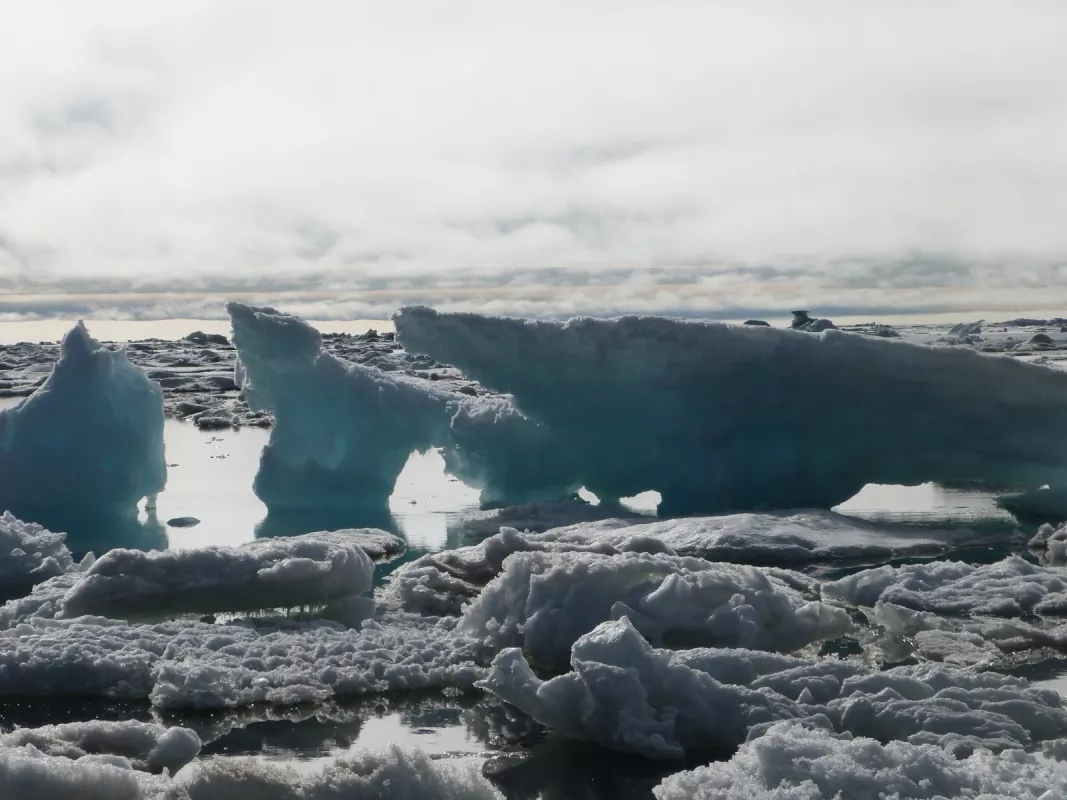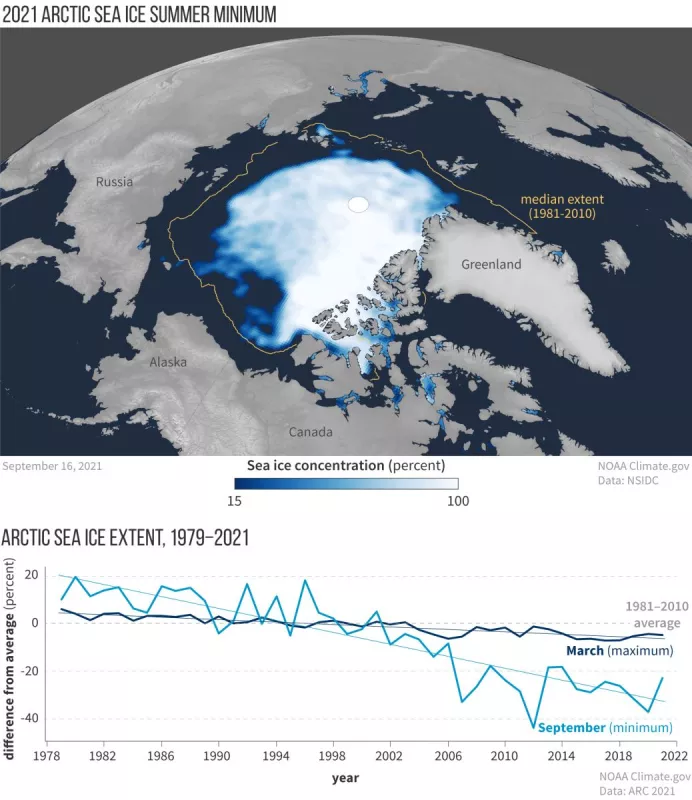A tipping point is a critical threshold where an incremental change could push a system over the edge to a new state. Two types of tipping points exist. One involves a rapid transition, like what happens when a canoe rocks back and forth. Eventually, it will flip over, but it is not irreversible. The other type of tipping point is irreversible in human time. For instance, a backcountry skier heads downhill, either on a steep or gradually sloped mountain (skiing quickly or slowly). But once the skier is at the bottom, it takes a long time to walk back up the mountain.
Once a tipping point is crossed, a self-accelerating dynamic takes hold, leading to a rapid transformation. Determining if and when a system may have a tipping point is important for climate projections because even if greenhouse gasses stop or are reduced, the system may be unable to easily or quickly recover back to its original state.
Scientists once thought that Arctic sea ice could have a tipping point because the upper ocean layer would retain too much heat, warming too much for sea ice to form again once melted. “This, however, has not stood up to modeling,” said Ted Scambos from the University of Colorado Boulder. Though Arctic sea ice has no definitive threshold, it is showing a rather significant trend in sea ice loss.
Arctic sea ice: some hope within a trend
Since the early 2000s, tipping points have emerged on the Antarctic and Greenland Ice Sheets, with a major global current known as the Atlantic Meridional Overturning Circulation (AMOC), and permafrost thaw. The question then begged to be asked of Arctic sea ice. A tipping point in the Arctic Ocean would mean losing so much ice that its heat-reflecting effects are severely diminished, leading to more and more ice loss. With this vicious cycle in place, ice could not recover to its previous summertime levels. After Arctic sea ice hit a record low in 2007, some scientists considered the possibility that sea ice has already passed this tipping point.
A 2011 modeling study from researchers at the Max Planck Institute in Germany suggested that sea ice could recover quickly, even if all the ice melted in the summer—showing that the feedback effects that would lead to a downward spiral in ice extent may be weaker than suspected. The study shed some good news for the Arctic. Researchers from the study do not argue against the mainstream view that a seasonally ice-free Arctic Ocean is inevitable. The issue is how we get there—with or without a tipping point.
Another study from 2016 showed that the decline in the observed sea ice extent correlates well with the increase in CO2 emissions. It is not a perfect match because there is variability in the ice extent from year-to-year, but “runaway” ice loss is not seen. This agrees with the 2011 modeling study.
The key to Arctic sea ice not having a tipping point is its winters. Arctic winters are shrouded in complete darkness and air temperatures drop below freezing. This causes the ocean to lose heat—enough for ice to rapidly form and grow and survive the next summer's melt.
Not if, but when
Even without a tipping point, researchers say, Arctic sea ice will continue on its downward trend. Since the satellite record began in 1979, Arctic sea ice has been declining in all seasons, with the month of September seeing the most drastic drop, about 13 percent per decade. As climate change continues, the warmer air and ocean will continue to thin multiyear ice. As multiyear ice is supplanted with first-year ice, the Arctic will be more vulnerable to triggers that cause rapid loss events. So while the tipping-point argument can perhaps be laid to rest, the Arctic will experience ice-free summers before 2050.
Now the question remains: How long before the Arctic Ocean is seasonally ice free? A study from 2021, used a computer model to simulate the length of open waters in the Arctic. By 2100, the changes will be dramatic, even though their model may be on the conservative side. The study suggests that with a 2°C (4°F) global warming, ice-free waters will lengthen by about 63 days in the central Arctic Ocean and by over 90 days in several surrounding seas. With a 3.5°C (6.3°F) increase, nearly the entire Arctic, including the Transpolar Sea Route, will be open for at least 3 months. With a 5°C (9°F), it will be open for at least 6 months.
On the flip side: Antarctic Ice Sheet
Tipping points help scientists identify vulnerable features of the climate system. The Intergovernmental Panel on Climate Change (IPCC) first introduced the concept of a tipping point involving abrupt and irreversible changes in the climate system in the early 2000s. Back then, the IPCC suggested such change would come with an increase in 5°C (9°F), but that has been since adjusted to 1°C to 2°C (2°F to 4°F).
In 2014, scientists found that irreversible and dramatic loss of glacial ice on the Antarctic Ice Shelf has been set in motion in the Amundsen Sea Embayment, where Thwaites and Pine Glaciers have been found accelerating. Antarctica, roughly the size of the United States and Mexico, appears to have several regions where a tipping point has already been crossed or is very near to being crossed. Computerized climate models have shown several situations where loss of ice from the ice sheet could suddenly accelerate without further increases in greenhouse gas emissions, even in the face of negative pressures like a reduction in greenhouse gas emissions.
As Earth’s frozen regions change dramatically, scientists will need to ask new questions and new concepts will emerge.
References
Crawford, A., J. Stroeve, A. Smith, et al. 2021. Arctic open-water periods are projected to lengthen dramatically by 2100. Communications Earth & Environment 2, 109. doi:10.1038/s43247-021-00183-x.
Notz, D., and J. Stroeve. 2016. Observed Arctic sea-ice loss directly follows anthropogenic CO2 emission. Science, 354(6313): 747-750. doi:10.1126/science.aag2345.
Serreze, M. C. 2011. Climate change: Rethinking the sea-ice tipping point. Nature, 471: 47–48, doi:10.1038/471047a.
Stroeve, J., and D. Notz. 2018. Changing state of Arctic sea ice across all seasons. Environmental Research Letters, 13: 103001. doi:10.1088/1748-9326/aade56
Tietsche, S., Notz, D., Jungclaus, J. H. & Marotzke. 2011. Recovery mechanisms of Arctic summer sea ice. Journal of Geophysical Research Letters 38, L02707, doi:10.1029/2010GL045698.

